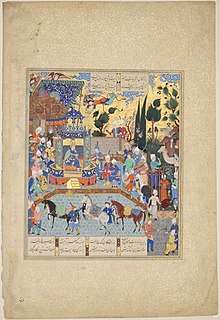Nasser Khalili
Nasser David Khalili (Persian: ناصر داوود خلیلی, born 18 December 1945) is a British-Iranian scholar, collector, and philanthropist based in London. He is a British citizen.[2] Khalili is the founder of the Khalili Collections, which is said to include the finest and most comprehensive collection of Islamic art in private hands.[3] Khalili was born in Iran, before leaving the country to study in the United States. He graduated from Queens College, City University of New York in 1974 with a computer science degree. He later received a PhD degree in Islamic art in 1988, from the School of Oriental and African Studies, London, writing his thesis on Islamic lacquerware.
Nasser Khalili | |
|---|---|
ناصر داوود خلیلی | |
| Born | 18 December 1945 |
| Alma mater | Queens College, City University of New York School of Oriental and African Studies |
| Occupation | Scholar Art collector Philanthropist |
| Spouse(s) | Marion Easton[1] |
| Children | Daniel Raphael Benjamin |
| Website | Khalili Collections website Khalili Foundation website |
He first started to collect art in New York during the 1970s, while also spending a lot of time in London investing in property during the 1980s. Over the coming decades, Khalili created eight distinct art collections under the auspices of the Khalili Family Trust. Khalili is said to have initially generated capital in the 1980s through the sale of a company and also venture capital. Since then his wealth has grown substantially, which he stated in an interview was due to "dealing in art, commodities and real estate". Khalili is known for the purchase of a number of large properties in London. One of his properties in Kensington Palace Gardens, was sold to Bernie Ecclestone for £57 million. He was also the co-owner of Sixty London on Holborn Viaduct, London. It is currently leased by Amazon as their London office.
In 1995, he founded the Maimonides Interfaith Foundation where he serves as Chairman. Khalili is a UNESCO Goodwill Ambassador and has addressed a number of high-level dignitaries on behalf of the United Nations and UNESCO. He is also a trustee of the City of Jerusalem and has received knighthoods from two Popes.[4][5][6]
Many commentators have drawn up different values for his works over the years, many valuations were made without public knowledge of what the collections contained. More accurate values have been published more recently after publications and exhibitions demonstrated what the collections contained.
When asked about his collections and wealth, Khalili stated in an interview that he "took it upon himself to buy everything that was available...I found things that belonged to a great heritage that was just sitting there unnoticed...They were displaced from history and deserved to be preserved and recognised".[7]
Early life and education
Khalili was born in 1945 in the city of Isfahan, Iran, the fourth of five children, to a Jewish family of art dealers and traders of artefacts.[8] Khalili and his family moved to Tehran, Iran, when he was only a few months old. By the age of eight, he was accompanying his father on buying expeditions, often buying items such as Persian lacquer and other Islamic arts.[9]
He studied in Tehran and wrote a book about the "geniuses of the world", aged 14. It was suggested in many news articles that Khalili had written the book following an argument with one of his teachers. After the book was published, Khalili featured on television discussing his book and also wrote columns in newspapers.[10]
Khalili completed his national service in Iran as a medic in the Iranian Army,[11] before leaving Iran in 1967 for the United States with $750 earned from sales of his book. He studied computer science and earned a BA degree in the subject at Queens College, City University of New York, and graduated in 1974.[8]
Business and collecting career
Khalili started his business career trading in art, before moving into property development and commodities. Khalili began collecting art in New York City in the 1970s, keeping the best pieces for his own collection.[10][7]
He began visiting London auction houses in the mid 1970s, and established his own gallery in Mayfair between 1978 and 1980.[9] Khalili initially traded in Persian lacquerware, and subsequently wrote a thesis on the subject, receiving a PhD degree in Islamic art from SOAS, University of London in 1988.[10] His focus on lacquerware also coincided with many undervaluing this art form. In 1978, the price of Islamic art fell substantially according to an article in Saudi Aramco World.[12] Aramco World stated in the article that Khalili continued to invest in Islamic art during this period and this was one of the reasons he was able to acquire so many high quality works for low prices.[12]
People close to Khalili stated that he invested wisely and often discreetly. In a London Evening Standard article, Michael Spink stated the following about Khalili's collection and growth of wealth; "he would buy items for £2,000 which, over a long period, appreciated to £200,000. People did not always realise that it was him doing the buying." Khalili's dealership was based in Mayfair's Clifford Street in the 1980s. When asked directly how he had gathered his wealth during the 1970s and 1980s, Khalili stated it was from sugar and coffee trading, the options market, property investments and works of art.[9]
In the mid-1980s, the scale of Khalili's collection greatly expanded. In the early 1990s, he began to publish a 27-volume catalogue of his Islamic art collection, for which he commissioned a number of leading Islamic scholars. In 1992, he was interviewed by The Independent following the launch of the first volume of this catalogue of Islamic art. According to the article, suspicions in the art industry were that Khalili was assembling the collection on behalf of a rich investor. The release of the collection under his own name stopped those suspicions and showed Khalili's collection as belonging to himself and his family.[13]
During the same period, Khalili was an art advisor to Hassanal Bolkiah, The Sultan of Brunei. Khalili subsequently helped persuade the sultan to donate £10 million to create the Brunei Gallery at SOAS, University of London.[13][8]
In 1992, Khalili offered to lend his Islamic art collection to the British government for a period of 15 years and on condition it is publicly displayed in a "museum building in central London". It was suggested that the museum would be known as the Khalili Museum, with the running costs of the museum and insurance to be publicly funded. The offer was made with the potential for turning the donation into a gift at the expiration of the 15-year period. The Conservative politician Lord Young of Graffham and the public relations executive Lord Bell lobbied the government to accept Khalili's offer.[10] Many expressed an interest in the proposal by Khalili for a London-based Islamic museum, including Prince Charles.
Khalili Collections
Khalili has assembled eight art collections under the auspices of the Khalili Family Trust. Collectively referred to as the Khalili Collections, they are divided into Islamic Art dating from 700 to 2000; Hajj and the Arts of Pilgrimage from 700 to 2000; Aramaic Documents from 353 BC to 324 BC; Japanese Art of the Meiji Period from 1868 to 1912; Japanese Kimono from 1700 to 2000; Swedish Textiles from 1700 to 1900; Spanish Damascened Metalwork from 1850 to 1900 and Enamels of the World from 1700 to 2000.[14] Together, the eight collections comprise some 35,000 works.
The Nasser D. Khalili Collection of Islamic Art is curated by Julian Raby, the Director of the Freer Gallery of Art and the Arthur M. Sackler Gallery. The collection has holdings of more than 28,000 objects documenting arts from Islamic lands over a period of 1,400 years. It was described in 1998 as "one of the largest and most representative collections of Quranic manuscripts in the world"[15] and is the largest private collection.[16] The collection includes manuscripts of the Holy Qur'an, rare and illustrated manuscripts, album paintings, bookbindings, lacquer, ceramics, glass and rock crystal, metalwork, scientific instruments, arms and armour, jewellery, carpets and textiles, coins and architectural elements.[17]
The Hajj and the arts of pilgrimage collection relates to Hajj and the arts associated with it. The works in the collection range from the Umayyad period to the 21st century. The collection aims to represent an overview of the subject, illustrating various religious and artistic aspects of the pilgrimages to various holy cities. The collection contains approximately 3,000 objects, including over 250 textiles and many other objects relating to Mecca and Medina. The combined collection is the second largest collection of its kind, with the Topkapı Palace museum the only larger collection globally.[17]
The Khalili Collection of Aramaic documents is a collection of 48 Aramaic documents from Ancient Bactria. The majority of the collection is made up of part letters and accounts connected with the court of the Satrap of Bactria. The significance of the documents is that they are the oldest correspondence of the administration of Bactria and Sogdiana. The documents are written in Official Aramaic and were likely from the historical city of Balkh. The documents are dated to a period of less than 30 years, between 353BC to 324BC. The newest of the documents were written during Alexander the Great's early reign in the region.[17]
The Japanese Art of the Meiji period collection is only comparable in terms of quality to the collection of the Japanese Imperial family.[18] It comprises over 1,400 pieces, including metalwork, enamels, lacquerwork and ceramics. The pieces are from the period of Emperor Meiji's rule from 1868 to 1912. The period saw a cultural revolution in Japan, where traditional tastes in Japan were met with international ones.[17]
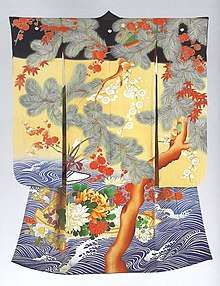
Khalili's second Japanese-based collection is the Khalili Collection of Kimono. This covers three hundred years of the Japanese textile industry and contains over 450 garments. The garments have been worn to demonstrate gender, age, status and wealth throughout Japan's history. The collection reveals a variety in kimono designs, illustrating how the design and use of kimono have changed over the centuries. The collection mainly represents four periods, the Edo period (1603-1868), the Meiji period (1868-1912), Taisho (1912-1926) and early Showa (1926–1989), with a few selected pieces produced later on.[17]
The Khalili Collection of Swedish Textiles comprises nearly a hundred textile panels, dating between 1700 and 1900. The majority of the works are from a one hundred-year period, and from the area of Scania, the southern-most region of Sweden. The textile collection contains art mostly made for wedding ceremonies in the region. While they played a part in the ceremonies, they were also a reflection of the artistry and skill of the weaver. Their designs often consist of symbolic illustrations of fertility and long life.[17]
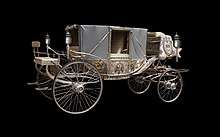
The Spanish damascene metalwork collection is one of the largest collections of its kind. The collection pays homage to the Zuloaga family, who played a major part in the preservation of damascening in Spain. The collection contains pieces commissioned by Plácido Zuloaga between 1834 and 1910. Some of the pieces were originally acquired by the 19th-century English collector Alfred Morrison. The entire collection comprises over 100 pieces, 22 of which are signed by Plácido Zuloaga.[17] At the opening of the Khalili Zuloaga exhibition at the Victoria and Albert Museum in London, its then director Alan Borg said it was "a landmark in the study of 19th century Spanish decorative art".[19]
The formation of the Enamels of the World collection was based upon the global significance and evolution of enamelling. The collection consists of over 1,300 pieces. Whereas enamels are usually studied with a particular focus, such as a geographical region, era or enamelling technique, Khalili's collection illustrates how enamelling has evolved throughout history on a global scale.[17]
The Khalili Collections will be fully represented in a series of over 100 books, including exhibition catalogues, of which over 70 have already been published.[20] Khalili estimated that the publication of the catalogues and associated research papers would cost him between £20-30 million.[10]
Exhibitions
Khalili's collections have featured in numerous museums and specialist exhibitions around the world. Selected objects from his collections have been shown in several major worldwide museums and been displayed as part of international exhibitions such as the British Museum,[7] the Victoria & Albert Museum and Somerset House (London); the State Hermitage Museum (St Petersburg); the Alhambra Palace (Granada); the Metropolitan Museum of Art (New York); Portland Art Museum (Oregon, US); and the Van Gogh Museum (Amsterdam).
The majority of Khalili's artworks are kept in storage in London and Geneva.
Property development
18–19 Kensington Palace Gardens
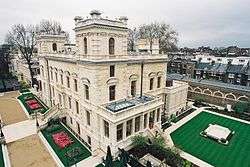
In 1995 Khalili bought 18 and 19 Kensington Palace Gardens for £40 million. 19 had been the former Egyptian embassy and 18 was formerly part of the Russian embassy.[9] Khalili's purchase of the property and its subsequent refurbishment cost £84 million. The works involving 400 craftsmen were believed to have been second in scale only to the restoration of Windsor Castle after the 1992 fire. Marble was imported from the same Indian quarry that had been used to build the Taj Mahal for pillars for the building. It was bought by businessman Bernie Ecclestone in 2001 for £54 million. Ecclestone later sold the property to industrialist Lakshmi Mittal.[21]
Sixty London
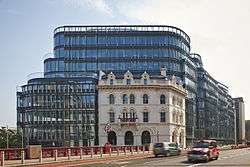
In 1997, Khalili bought Bath House, an office building on Holborn Viaduct for £7 million. In 2007 planning permission was granted for an 11-storey office building called The Wave and in 2009 Khalili acquired the freehold from the crown estates. The building, which eventually completed in 2013, was designed by the architects Kohn Pederson Fox Associates. Since 2010 the project had been a partnership between Khalili's property company Favermead and AXA Real Estate Investment Managers.[22] The new 230,000 sq ft building was later leased by Amazon in 2013.[23][24] In 2014 the building became one of the 13 winners in the Urban Land Institute’s Global Awards for Excellence, citing the blending of modern and historic architectural elements.[25]
Philanthropy
Through his foundations and trusts, Khalili has made many substantial donations to a number of different organisations, institutions, and charities. Donations in the field of education include an endowment of £2.5 million to the University of Oxford.[26] The funds were used for the establishment of the Khalili Research Centre for the Art and Material Culture of the Middle East, which was opened by the Chancellor of Oxford University, Lord Patten, in July 2005.[27] The Khalili Family Trust's support continues to the present day, notably with another substantial donation in 2011.
In 1989, Khalili donated £600,000 to establish The Khalili Chair of Islamic Art at the School of Oriental and African Studies, University of London. He also gave a further £200,000 in 2003 for the refurbishment of the lecture theatre at the school. Furthermore, in 1992, he made an endowment of £51,000 to the University of Oxford for a Research Fellowship in Islamic Art.[28]
In the early 1990s, he was solely responsible for securing £10 million from H.M. the Sultan of Brunei to build the Brunei Gallery at School of Oriental and African Studies. In 2012, he pledged over £1.5million in support of his charity, The Maimonides Interfaith Foundation, in celebration of the Queen's Diamond Jubilee.
Khalili founded the charitable Maimonides Interfaith Foundation in 1995 to promote "understanding, cooperation and peace between Jews, Christians and Muslims internationally through art, culture and education".[7][29] The foundation created the Maimonides Interfaith Explorers, a free online educational resource for children aged 10 to 11.[30]
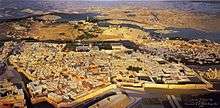
In the 1990s, Khalili commissioned a series of five paintings by the artist Ben Johnson called the House of Peace to promote "peace and harmony" between Judaism, Christianity and Islam.[31] The foundation also donated thousands of copies of The Timeline History of Islamic Art and Architecture (Visions of Splendour), written by Khalili, to schools in the United Kingdom and Islamic countries.[32]
Recognition
He has been awarded many other honours, including Trustee of the City of Jerusalem,[33] and in 2007 the High Sheriff of Greater London Award for his cultural contribution to London. He is Knight Commander of the Royal Order of Francis I (KCFO).[33] He is exceptional in having received Knighthoods from two Popes. Pope John Paul II honoured him as Knight of the Pontifical Equestrian Order of St Sylvester (KSS) and Pope Benedict XVI further elevated him to Knight Commander in the said order (KCSS) for his work in the pursuit of peace, education and culture amongst nations.[33] In 2012, he was further honoured in this field by UNESCO, as a Goodwill Ambassador.[34] In 2014, he was the recipient of the Laureate of the Dialogue of Cultures Award at the French National Assembly and consequently in early 2016 he was awarded the Rank of Officier in the Ordre national de la Légion d’Honneur by the French president. He was appointed as a member of the Honorary Board at the INTERPOL Foundation for a Safer World (2018 - 2019).[35]
Honours and awards
- Honorary Fellow, School of Oriental and African Studies, University of London (1991)[36]
- Trustee of the City of Jerusalem (1996)[5]
- Knight Commander of the Royal Order of Francis I (shortened to KCFO) (2003)[37]
- Honorary Degree Doctor of Humane Letters, Boston University (2003)[38]
- Knight of the Equestrian Order of Pope St Sylvester (shortened to KSS) (2004)[36]
- Honorary Doctor of the University of the Arts, London (2005)[39]
- Honorary Fellow of Wolfson College, Oxford (2005)[39]
- Member of Chancellor's Court of Benefactors, Oxford (2006)[40]
- High Sheriff of Greater London Award (2007)[41]
- Knight Commander of the Pontifical Equestrian Order of St. Sylvester (shortened to KCSS) (2009)[42]
- Queens College, New York President's Award (2010)[43]
- UNESCO Goodwill Ambassador (2012)[6]
- Queens College, New York President's Medal in Recognition of His Outstanding Service to Humanity (2013)[44]
- Aladdin Award for Dialogue Among Cultures at the French Assembly (2014)[45]
- Honorary Degree, Doctor of Humanities, Honoris Causa from Professor Gregory Warden Presidend, Franklin University, Switzerland (2015)[46]
- Rank of Officier in the Ordre national de la Légion d’Honneur, France (2016)[47]
- Member of the Honorary Board, INTERPOL Foundation for a Safer World (2018 - 2019) .
- Eurasian Legend Award, Eurasia Academy, Baku, Azerbaijan, 2019 [48]
UNESCO goodwill ambassador
In 2012, Khalili was honored by UNESCO as a goodwill ambassador for his work in the pursuit of peace, education and culture amongst nations.[6][49] In his role as goodwill ambassador, Khalili spreads the ideals of UNESCO through his position as a scholar, collector and philanthropist. He helps galvanize public interest and support for the purposes and principles of UNESCO to significant audiences.[50]
He has addressed dignitaries, politicians, civil society leaders and religious authority figure at a number of UNESCO events on a range of themes.[51][52][53]
He has made keynote addresses at the launch of the "International Decade for the Rapprochement of Cultures" in a UNESCO International Forum held in Kazakhstan, in 2013;[51] at the UNESCO International Congress of May 2013 in China where he spoke about Culture: Key to Sustainable Development;[53] and at the King Abdulaziz Center for World Culture in Saudi Arabia in December 2013 to mark the launch of the UNESCO forum on Building Knowledge Societies for Sustainable Human Development.[54] In January 2015, he addressed dignitaries and journalists on Intercultural Dialogue in Fragmented Societies at the UNESCO headquarters as part of an event organised in the wake of the January 2015 Île-de-France attacks in Paris.[55]
Financial
In a 2010 interview Khalili said that his collecting in the mid 1980s was funded by his dealings in venture capital, having profited from shares in a company that developed technology to treat tumours, and that he made $15 million from the sale of a company that manufactured indigestion pills in 1987.[8] In 1992, Khalili had described his wealth as deriving from "dealing in art, commodities and real estate".[10] Khalili has said that his collecting was primarily funded by his property investments from 1980.[8]
In 2007 Khalili's wealth was estimated at £5.8 billion by the Sunday Times Rich List, but he was removed from subsequent editions of the list. In 2007 and 2008 Forbes estimated Khalili's wealth at $1.3 billion, but he dropped off the 2014 edition of the list.[56] In 2008 The Art Newspaper wrote that "a £1 billion valuation is believed more likely" than previously claimed higher amounts.[9] Khalili has claimed that he has spent $650 million on art.[9]
References
- Syndney Morning Herald: "For the love of art: Iranian student with $US750 turns billionaire" 31 March 2010
- "Biographical Notes" in Earle, Joe (ed.) Shibata Zeshin: Masterpieces of Japanese Lacquer from the Khalili Collection. London: Kibo Foundation, 1997. p80.
- "Healing the world with art". The Independent. 15 April 2004.
- "Maimonides Interfaith Foundation". Charter for Compassion.
- "Prof. Khalili Trustee of the City of Jerusalem certificate". Wikimedia commons.
- "British entrepreneur Nasser David Khalili named UNESCO goodwill ambassador". United Nations. 16 October 2012.
- Susan Moore (12 May 2012). "A leap of faith". The Financial Times. Retrieved 7 March 2015.
- William Green (30 March 2010). "Iranian Student with $750 Turns Billionaire Made by Islamic Art". Bloomberg L.P. Retrieved 7 March 2015.
- Hollingsworth, Mark (27 March 2009). "The Treasure Seeker". Evening Standard magazine. pp. 14–18.
- Norman, Geraldine (13 December 1992). "Art Market: Mysterious gifts from the East: Who is the man who has collected Islam's finest treasures and offered them to Britain as a pounds 1bn bequest? Geraldine Norman finds out". The Independent.
- "Professor Nasser D. Khalili". Debretts People of Today. Debretts. Retrieved 6 March 2016.
- Shah, Tahir (December 1994). "The Khalili Collection of Islamic Art". Saudi Aramco World.
- Norman, Geraldine (12 December 1992). "Art Market: Mysterious gifts from the East: Who is the man who has collected Islam's finest treasures and offered them to Britain as a pounds 1bn bequest?". The Independent.
- "Eight Collections". The Khalili Collections.
- Irwin, Robert (November 1998). "Review: Calligraphic Significances: Catalogues of the Nasser D. Khalili Collection of Islamic Art". British Journal of Middle Eastern Studies. Taylor & Francis. 25 (2): 355–361. JSTOR 40662688.
- "The Abbasid Tradition: Qur'ans of the 8th to the 10th centuries AD". Khalili Collections. Retrieved 10 September 2019.
- The Khalili Family Trust (2014). The Khalili Collections - A Publication and Exhibition History. Park Communications.
- "Renowned collector Nasser Khalili revealed as buyer of 'lost' monumental Meiji vase as he reunites it with original set". www.antiquestradegazette.com. Retrieved 30 September 2019.
- "Comments & Reviews". nasserdkhalili.com. December 2009. Retrieved 10 September 2019.
- "Mittal Tops Sunday Times U.K. Rich List; Billionaire Club Grows". Bloomberg. 28 April 2007.
- "Bernie Ecclestone sold £57m dream home after his wife refused to move in". Daily Telegraph. 6 March 2009. Retrieved 6 March 2016.
- James Buckley (2 December 2010). "AXA Real Estate and Favermead complete Bath House tie-up". Estates Gazette. Retrieved 6 March 2016.
- "Qataris have sticky time while judge struggles to tell ancient from modern". Evening Standard. 28 May 2010. Retrieved 6 March 2016.
- Christopher Williams (28 May 2010). "Amazon signs lease on 210,000 sq ft central London offices". Daily Telegraph. Retrieved 6 March 2016.
- "Sixty London 2014 Global Awards for Excellence". 21 October 2014.
- "£2m gift for Middle Eastern art". BBC. 9 July 2004.
- Webmaster. "The Khalili Research Centre". Oxford University. Archived from the original on 1 February 2017. Retrieved 9 May 2016.
- "About the Chairman". Maimonides Foundation.
- "Maimondes Interfaith Foundation - About us". Maimonides Interfaith Foundation website. maimonides-foundation.org. Retrieved 5 March 2016.
- "MIE". Maimonides Interfaith Explorers website. interfaithexplorers.com. Retrieved 5 March 2016.
- "House of Peace". Nasser Khalili website. nasserdkhalili.com. Retrieved 5 March 2016.
- "Visions of Splendour in Islamic Art and Culture". Nasser Khalili website. nasserdkhalili.com. Retrieved 5 March 2016.
- "Khalili". Retrieved 9 May 2016.
- http://unesdoc.unesco.org/images/0021/002180/218064e.pdf
- "Interpol Foundation: Board of Trustees and Honorary Board" (PDF).
- "School of Oriental and African Studies Honorary Fellows". University of London.
- "Members of the Royal Order of Francis I". Sacred Military Constantin Order of Saint George.
- "Boston University bestows seven honorary degrees". Boston University. 6 June 2003.
- "Prof Nasser Khalili". Wolfson College, University of Oxford.
- Spero, Josh (5 February 2012). "Why Oxford University Couldn't Survive without Philantropy". Turk of America.
- "Appointment of Sheriffs". London Gazette. 7 March 2007. p. 3313.
- Ziabari, Kourosh (5 February 2016). "Iran and Britain: Bracing for a New Era of Redefined Relations". Huffington Post.
- "Queens College Announces New Nasser Khalili Visiting Professor". Queens College. 6 July 2011.
- "Commencement Ceremonies for 2013". Queens College. 2 May 2013.
- "Former French Culture Minister Jack Lang awards the Aladdin Award to Professor Nasser David Khalili". Aladin Project.
- "From College to University - Franklin Celebrates" (PDF). The Franklin Gazette. 2015.
- "Professor Khalili awarded the rank of officier in the Ordre national de la Légion d'Honneur by the French President". Nasser Khalili News. 11 April 2016.
- "Nasser David Khalili | Professor Khalili is elected to the Eurasian Academy". Nasser David Khalili. 17 May 2019. Retrieved 21 July 2020.
- "Honorary and Goodwill Embassador - Nasser David Khalili". UNESCO.
- Davies, Karen. "British Entrepreneur, Nasser David Khalili, appointed as UNESCO Goodwill Embassador". UNRIC.
- "International Decade for the Rapprochement of Cultures (2013-2022)" (PDF). UNESCO. 10 June 2013.
- "Investing in Cultural Diversity and Intercultural Dialogue" (PDF). United Nations.
- Multiple authors (15 May 2013). "How does culture drive and enable social cohesion and inclusion?" (PDF). UNESCO.
- "Global Knowledge Society Forum 2013 - Building Knowledge Societies for Sustainable Human Development". UNESCO. 2013.
- "Day of Debate at UNESCO: Journalism after Charlie". UNESCO. 14 January 2015.
- "Nasser Khalili". Forbes. Retrieved 17 April 2016.
